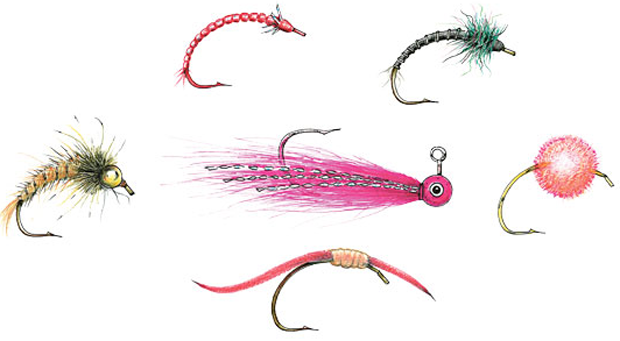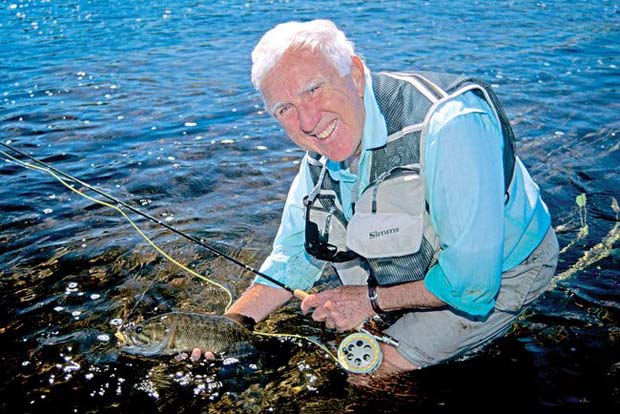[dropcap]P[/dropcap]anfish are a four season target in the South with the spring and fall being prime time (temperature reaches 70 degrees F = spring and fall spawn). The further North one goes opportunities for good bluegill and other panfish fishing diminishes in the winter.
Panfish are in thee large sunfish family of spiny-rayed predators such as largemouth bass, smallmouth bass, spotted bass, and five other Southern bass species.
Bluegill are in their own fraternity of sunfish
For example, coppernose, redear (shellcracker), redbreast, yellowbelly, longear, crappie, green sunfish, common sunfish, warmouth, rock bass and yellow perch. All take trout flies and are succesfully fished for using the same tactics employed for trout – stillwater or rivers.
Dave Whitlock, the reigning authority on the subject of panfish, wrote: “They are widely distributed, self-proliferating, hardy, strong, beautiful, and aggressive fly eaters. After a lifetime of fly fishing, I’m always eager to take on sunfish.”
Panfish fly fishing is a low budget affair
A 2- or 3-weight is all the ammo you need for panfish. A glass rod can be had for under $100, a reel for under $100, a fly line for under $50 and if you tie your own flies it gets even cheaper. There is not a state in the continental US that does not have legions of panfish. They are extre,ely hardy and aggressive. To find them is even easier. Every state has department of natural resources (each state calling its DNR by other names) will list their whereabouts, and in some cases, where exactly they are found at a given point in a season (Georgia, for example).
Flies
The flies that are used for panfish are always small (some folks believe in bigger flies that would catch a big 2-pounder, but most anglers prefer action, and that means smaller flies). No bigger than a #10 and most in the high teens and even low twenties. Panfish have small mouths and inhale their food so sensing a bite is somewhat problematic, but an indicator (4- or 5-feet from the leader solves that. Panfish readily take dry flies so surface flies are always in play. Deeper swimming flies are more in play in the colder and hotter months.
The six flies illustrated below by Dave & Emily Whitlock are (#14-18) and are Whitlock’s favorites for late fall, winter, and early spring bluegill. Top to bottom: midge larva, midge pupa, Red Fox Squirrel Nymph, mini jig, single egg, San Juan Worm. In, addition, I have found inchworms, sucker spawn, catapillar, Red Tailed CatapilTlar, Beadhead Red Tail, Brim Buster, caddis lava, foam ant and nymphs good all round flies for panfish.
 The importance of the spawn
The importance of the spawn
All panfish spawn in spring when water temperature rises above 70 degrees F. Males create nests by digging small depressions in water ranging from 1-to 4-eet deep. Soon after, the females join them to spawn.
Dave Whitlock wrote: “Females leave after spawning and males guard the eggs, circulating water over the nest to aerate it and prevent silt from settling around the eggs. Some fish return to these same bedding areas in the fall to spawn before water temperatures drop below 70 degrees.
Just before, during, and a week after spawning, males are aggressive near their nests and strike almost any fly that comes into range. In most bluegill fisheries, larger males tend to spawn in deeper water. I’ve observed them on nests 10 to 25 feet deep. I’ve also found that each bluegill season some males spawn so often they waste away and die—what a way to go!”
Tippets
The bets bets for encouraging eats are using no greater than 4X—and 5X, or 6X, and even 7X tippets. Hooking and landing a foot long bluegill or other panfish is akin to catching a large brown trout, and very challenging on a 7X.
Dave Whitlock
Dave Whitlock wrote: “After a lifetime of fly fishing for bluegill, I’ve also found that the slower you fish the fly, the more and larger fish you can expect. Bluegill and other sunfish often miss and quickly lose interest in fast-moving foods and flies. Dry flies, Sponge Spiders, Sneaky Petes, mini jigs, San Juan Worms, eggs, nymphs, and midge larvae are magic if simply suspended just above or at a lurking bluegill’s level.
Occasionally, a large hair or popping bug raises a moody bluegill when small flies won’t, but it’s hard to hook them on these big bites. When this occurs, attach 8- to 10-inches of 4X or 5X tippet at the bend of the big hook with a tight Duncan loop and tie on a #12-14 nymph dropper.”
[information]
The Featured Image is of Dave Whitlock. He has developed many fly patterns that are still widely used by today’s fly fishermen. Photo credit Emily Whitlock.
[/information]







